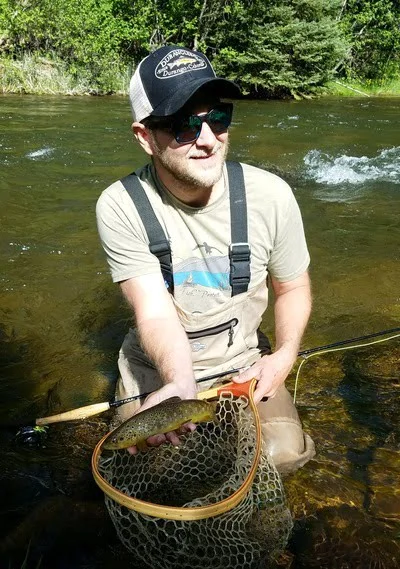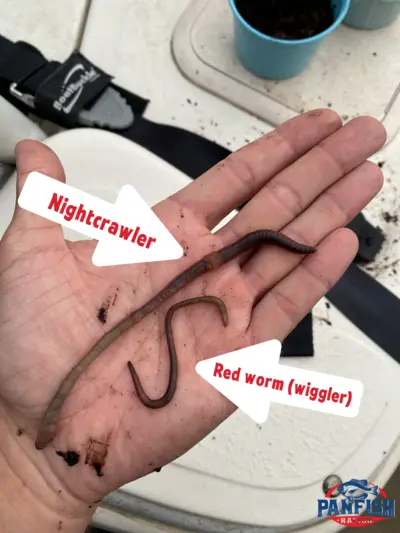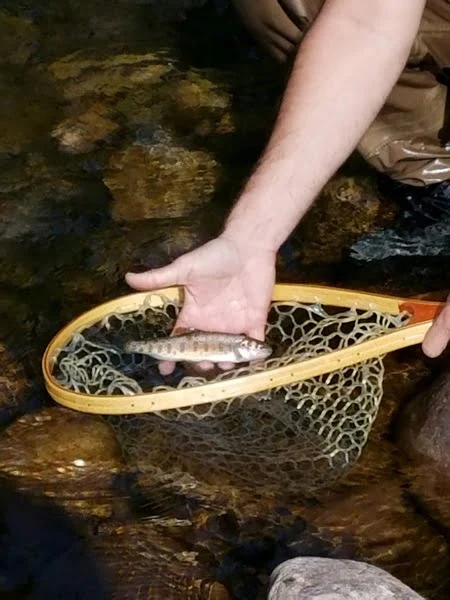When most people think of trout fishing, they picture a gentle flowing stream and the graceful cast of a fly rod on a cold misty morning…
And while that is one of the most popular and beautiful ways to catch trout…there are other ways too, like trout fishing with worms!
If you don’t want to use a fly-rod to catch trout, that is perfectly okay.
In this article, I’m going to share my tips on using trout fishing worms, how to rig them, and get you more bites!
Table of Contents
Can You Use Worms to Catch Trout?
Trout fishing with live worms is very popular and effective, especially on pay-to-catch farms, stocked lakes, and during fishing derbies. Worms are a natural food source for all species of trout, which feed heavily on insects and invertebrates.
It is important to do your homework on the state and area that you intend to fish and confirm if you can use worms (live bait) for trout.

Certain rivers, creeks, and even counties or lakes may prohibit it. Always brush up on the rules and regulations!
What Are the Best Worms for Trout Fishing?
Believe it or not, not all types of fishing worms work well for trout. These small fish are often intimidated by larger worms. Trout have smaller mouths when compared to other species of fish and prefer to consume smaller-sized worms.
Luckily, many types of worms work very well for trout. Larger species of worms can even be adapted to work with your fishing setup to catch trout.
Red wigglers are one of the most popular and best fishing options for catching trout. Their smaller size and erratic movements drive trout crazy, enticing bites when other types of baits and worms can’t.
Nightcrawlers can also be used for trout, but they need to be cut into smaller pieces. When they are cut, they release a strong scent that can also help attract nearby fish.

They will not, however, stay alive as long after you cut them into smaller pieces.
Mealworms are another excellent option for trout. Their small size and bright colors allow them to stand out in murky water.
While more popular for catching trout through the ice in the winter, mealworms also make a great bait option for early spring trout or lake fishing for trout.
How To Rig Worms for Trout Fishing
If you are seeing a lot of stocked trout but can’t get them to bite…one of the things you can try is a simple live worm rig. Not only do worms work extremely well for trout, but they are very versatile.
Trout fishing worms can be used in a variety of different rigs. These rigs will be able to cover all of your bases, no matter what depths or conditions the trout are living in.
Using a Bobber
One of the best methods of catching trout with worms is to use a slip bobber rig.
This versatile setup allows you to fish at a wide range of water depths by simply changing the position of the bobber.
To make a slip bobber rig, you will first need a few basic items:
- Size 8 to 12 bait hook
- Small to medium size sliding bobber
- Plastic bead
- Bobber stoppers
- 6 to 12 lb test fishing line (monofilament or fluorocarbon)
- ¼ to ½ ounce split shot weights
When you have all of the items needed to make a bobber rig, there are just a few basic steps to create and assemble them.
- Thread your fishing line through the tube of the bobber stopper, moving it up the line a few feet. Slide the stopper knot off the tube, pulling the ends to tighten the knot on the line. Remove the tube of the bobber stopper from the line.
- Thread your line through the plastic bead, followed by the hollow tube of the slip bobber. Add a split shot weight to the line just below the slip bobber in order to prevent it from sliding down the line.
- Tie the end of the line to the hook. I prefer using a Palomar knot or a fisherman’s knot if I’m using a large enough hook.
- Set the depth that you wish to fish by sliding the bobber stopper up or down the fishing line. Keep a split shot weight around a foot away from your hook to ensure it sinks down into the water.
- Add a #8 worm onto your hook. Ensure that it is threaded through the hook three to four times. Your bobber rig is now ready to start fishing with. Readjust the depth of the hook by sliding the bobber stopper as necessary.

Split Shot Rig
The split shot rig is very popular, just like a slip bobber rig, and is even easier to make. This rig excels at fishing in waters that are less than 20 feet deep and near the bottom.
To make a split shot rig, you will need many of the same basic components of a bobber rig (minus the bobber). This includes:
- 6 to 8 lb test monofilament or fluorocarbon fishing line
- Size 8 to 12 bait hook
- 2 split shot weights (¼ to ½ ounce in weight)
- Snap swivel
- Pair of pliers
To assemble a split shot rig, you only need to follow three basic steps:
- Cut a length of the fishing line around 4 feet in length to serve as your leader. Attach the snap swivel to the end of the fishing line and one end of the leader. This will prevent any twisting of the main fishing line.
- Tie your hook onto the other end of the leader. Take both split shot weights and use the pliers to place them on the leader around 2 feet above your hook. There should be an inch between the two split shot weights.
- Place a #8-#10 worm on the hook by carefully threading it on two or three times. Leave an inch or two or the worm hanging off the end to provide movement to attract fish. Readjust the position of the weights depending on conditions.
See Also: Palomino Trout – Trophy Fish or Just Another Rainbow?
Slip Sinker Rig
The concept of a slip sinker rig works by not allowing the trout to feel the weight of the fishing line when they go to eat the worm.
It functions similar to a slip bobber rig, with the main difference being that it can function at the bottom and in deeper water.
To make a slip sinker rig, you will need the following materials:
- 6 to 8 lb test fishing line (monofilament or fluorocarbon)
- Swivel
- Size 8 to 12 bait hook
- 1 egg sinker (¼ to ¾ ounce in weight)
To make a slip sinker rig, you only need to follow a few simple steps:
- Cut a length of line (around 3 to 4 feet) from the main fishing line to serve as a leader. Afterward, thread the main line through the egg sinker and tie it onto one end of the swivel.
- Take the leader that you cut and tie one end to the other side of the swivel. Next, tie your hook onto the free end of the leader. Use a secure knot like a fisherman’s knot to ensure it doesn’t come loose while fishing.
- Your main fishing line should now be able to slide through the egg sinker until it comes into contact with the egg sinker. You are now able to bait your hook with a worm and cast it out.
- Allow this rig to completely sink to the bottom. Take up any extra slack in the line. Once a trout starts to take your worm, wait a few moments to set the hook.
Tips When Using Worms to Catch Trout
Using worms can significantly increase your success when fishing for trout if you know what you are doing.

- Reel in your line and check your hook every 15 to 20 minutes to ensure your worm is still attached.
- When fishing for rainbow trout, ensure that your worm is pierced at least 3 or 4 times. These fish are notorious for being able to cautiously steal worms off a hook without you feeling it.
- Larger trout species, such as lake trout, will require larger worms. Utilize large nightcrawlers and earthworms for the best results.
- When fishing fast waters for species like brown trout, cast your worm upstream and let it drift down to where you suspect the fish are hiding.
Why Are Worms So Effective?
Live worms have most likely caught more trout than any other type of bait or lure, combined.
So why are worms so effective when it comes to catching small fish like trout?
Trout will willingly eat a variety of different worms like nightcrawlers, red wigglers, mealworms, and others. Worms make up a natural part of a trout’s diet and can produce some amazing success when used correctly.
Worms are readily available at most bait shops, they require little upkeep or maintenance, and you can even catch your own to save a few bucks.
If you haven’t guessed yet, I love fishing and everything about it!
To learn more about why I started Panfish Nation, visit the About page and follow along on Social Media:


Download a copy of my FREE Lure Color Selection Chart & Knot Guide!
Stay up to date with fishing reports, tackle reviews, industry news, and much more! We respect your privacy, unsubscribe at any time.
